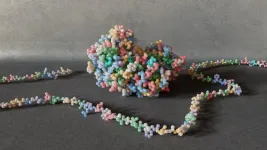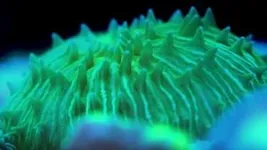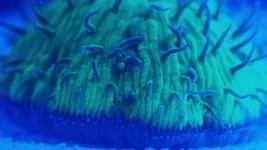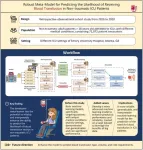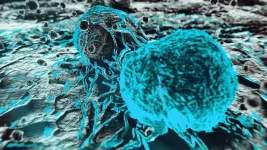(Press-News.org) Enzymes are crucial to life. They are nature’s little catalysts. In the gut, they help us digest food. They can enhance perfumes or get laundry cleaner with less energy. Enzymes also make potent drugs to treat disease. Scientists naturally are eager to create new enzymes. They imagine them doing everything from drawing greenhouse gases out of the skies to degrading harmful toxins in the environment.
That age-old quest for new enzymes just got a whole lot easier. A team of bioengineers and synthetic biologists has developed a computational workflow that can design thousands of new enzymes, predict how they will behave in the real world, and test their performance across multiple chemical reactions – a workflow that takes place on a computer. Their results are published in a new paper in the journal Nature Communications.
“We’ve developed a computational process that allows us to engineer enzymes much faster, because we don’t have to use living cells to produce the enzymes, as is now the case,” said Michael Jewett, a professor of bioengineering at Stanford University and senior author of the new study. “Instead, we use machine learning to predict highly active designer enzymes that have been engineered from mutated DNA sequences modeled on the computer instead of created by hand in the lab. We can carry out these experiments in days rather than weeks or, as is often the case, months.”
Old science, new models
Historically, scientists working to engineer new enzymes had to start with an enzyme already known to nature. Then, using real, genetically modified cells in the lab, they iteratively make changes to the enzymes to coax them to carry out the desired chemistry the researchers hope to achieve.
The DNA needed for these enzyme variants must be purchased from a third-party vendor. The DNA must then be transferred manually into cells to produce the enzymes of interest, which then must be purified and tested across a range of chemical reactions. Sometimes, Jewett said, it can take thousands of iterations – perhaps even tens or hundreds of thousands – to try to find a single enzyme that might deliver the chemistry that a scientist is aiming to achieve.
“We can now do all that on a computer,” he adds. “Rather than having to run 10,000 chemical reactions to iteratively improve enzyme activity, we can use machine learning models to predict highly active variants that still do just as well.”
The science of enzyme engineering is not new, only the application of machine learning to the field. Jewett and colleagues know it as “directed evolution.” They are shortcutting the process nature itself has gone through over the ages as DNA mutates by chance and new enzymes result, sometimes with important results. Enzymes are, after all, just proteins made up of long strings of amino acids. DNA directs the production of the strings. Change the DNA; change the enzymes.
“It is the structure of the proteins – which is created from the sequence of those amino acids in the molecule – that leads to their function,” Jewett said. “Directed evolution is a decades-old field that has developed the ability to mutate amino acids to change the function of the protein. We’re just speeding up the process using machine learning and computers.” A key feature of the team’s workflow is the ability to synthesize and test protein enzymes in cell-free systems without living intact organisms, which further accelerates the process.
Future-focused
As a proof of concept, Jewett and colleagues used their new tool to synthesize a small-molecule pharmaceutical at 90% yield – up from an initial 10% yield – and show it can be applied to build multiple specialized enzymes in parallel to make eight additional therapeutics. He is now looking for a pharmaceutical partner to further develop the model. More broadly, Jewett’s group has interest in expanding his machine learning models to guide catalysis or enzyme function across many different types of chemical reactions. In this paper, the team only looked at amide bond formation, a ubiquitous chemical reaction important in many different areas from pharmaceuticals to foods. But there are other opportunities.
“We could explore multiple opportunities in sustainability and the bioeconomy. You could begin thinking about classes of molecules that degrade toxins from the environment, enhance bioavailability of protein-rich foods, or others that take existing processes that require high pressures, costly components, or toxic reactions and make them faster, safer, and less expensive,” Jewett said.
Jewett and colleagues’ work was not without its roadblocks, most notably a lack of data. “High-quality, high-quantity functional data remains a challenge,” he said. “We all know AI needs lots of data, and at this point it’s just not there.”
In the context of directed evolution and biocatalysis, generating large amounts of data for carrying out those chemical reactions is not something that is commonly reported in the scientific literature, Jewett said. The process of generating the data is just too slow. But, as science comes to use machine learning models more and more to accelerate design, those data needs will only increase, Jewett said, pointing to future work. In this study, Jewett was ultimately able to assess about 3,000 enzyme mutants across about 1,000 products and about 10,000 chemical reactions, but his data needs are orders of magnitude greater.
“If I wanted to mutate an enzyme to test tens of thousands of variants,” Jewett said, providing a concrete example for scale, “I might find papers out there, but they may report mutant data for ten variants. Not hundreds. Not thousands. Not tens of thousands of reactions, but ten. So, we have a way to go on the data front, but we’ll get there. This is the first step.”
Contributing authors on this work include Grant M. Landwehr, Jonathan W. Bogart, Carol Magalhaes, Eric G. Hammarlund, and Ashty S. Karim at Northwestern University. This work was made possible in part by grants from the NCI Cancer Center, Department of Energy Defense Threat Reduction Agency, National Institutes of Health, and LDRD Program at Sandia National Laboratories.
END
In the hunt for new and better enzymes, AI steps to the fore
2025-01-22
ELSE PRESS RELEASES FROM THIS DATE:
Females have a 31% higher associated risk of developing long COVID, UT Health San Antonio-led RECOVER study shows
2025-01-22
SAN ANTONIO, Jan. 22, 2025 – Females have a 31% higher associated risk of developing long COVID, with women aged 40 to 55 years having the highest propensity, according to a study led by The University of Texas Health Science Center at San Antonio (UT Health San Antonio) funded by the National Institutes of Health.
The findings are part of a nationwide initiative launched by NIH, called Researching COVID to Enhance Recovery, or RECOVER, to understand the long-term health effects of COVID-19.
The latest ...
Final synthetic yeast chromosome unlocks new era in biotechnology
2025-01-22
Macquarie University researchers have worked with an international team of scientists to achieve a major milestone in synthetic biology by completing the creation of the final chromosome in the world's first synthetic yeast genome.
This achievement represents the completion of the global Sc2.0 project to create the world's first synthetic eukaryotic genome from Saccharomyces cerevisiae (baker's yeast) and a new-to-nature tRNA neochromosome.
Using cutting-edge genome-editing techniques, including the CRISPR D-BUGS protocol, the team identified and corrected genetic errors that impacted yeast growth. These changes restored the strain’s ability to grow on glycerol, ...
AI-powered prediction model enhances blood transfusion decision-making in ICU patients
2025-01-22
Researchers at Emory University have developed a groundbreaking artificial intelligence (AI) model capable of accurately predicting the likelihood of blood transfusion in non-traumatic intensive care unit (ICU) patients. Published in Health Data Science, the study addresses longstanding challenges in predicting transfusion needs across diverse patient groups with varying medical conditions.
Blood transfusions are critical in managing anemia and coagulopathy in ICU settings, yet current clinical decision support systems often ...
MD Anderson Research Highlights for January 22, 2025
2025-01-22
HOUSTON ― The University of Texas MD Anderson Cancer Center’s Research Highlights showcases the latest breakthroughs in cancer care, research and prevention. These advances are made possible through seamless collaboration between MD Anderson’s world-leading clinicians and scientists, bringing discoveries from the lab to the clinic and back.
Novel allogeneic NK cell therapy from induced pluripotent stem cells shows encouraging efficacy in relapsed or refractory B-cell lymphoma patients
Patients ...
Scholastica announces integration with Crossmark by Crossref to expand its research integrity support
2025-01-22
CHICAGO, IL (January 22, 2025) — Scholastica, a leading software solutions provider for academic journals, has released a new integration with Crossmark by Crossref, the industry standard mechanism for reporting updates to published research.
The Crossmark integration is now available to journals subscribed to the Scholastica Open Access Publishing Platform that are published by a Crossref member organization participating in the Crossmark service.
“Clearly communicating article updates and retractions is critical to maintaining the integrity of the scholarly record, and with this ...
Could brain aging be mom’s fault? The X chromosome factor
2025-01-22
Women are born with two X chromosomes and inherit one from each parent. But in every cell of their body, just one X chromosome is needed – so the other is randomly inactivated. Some cells use only a maternal X chromosome; others rely only on the paternal X.
Now, UC San Francisco researchers have found that when the brain cells of female mice express only a maternal X chromosome, their memory and cognitive skills deteriorate faster than female mice that express both maternal and paternal X chromosomes.
The discovery, which appears Jan. 22 in Nature, could explain the variation in brain aging between the sexes, since males inherit only a maternal X, as ...
Subterranean ‘islands’: strongholds in a potentially less turbulent world
2025-01-22
Deeply hidden in Earth’s mantle there are two huge ‘islands’ with the size of a continent. New research from Utrecht University shows that these regions are not only hotter than the surrounding graveyard of cold sunken tectonic plates, but also that they must be ancient: at least half a billion years old, perhaps even older. These observations contradict the idea of a well-mixed and fast flowing Earth’s mantle, a theory that is becoming more and more questioned. “There is less flow in Earth’s ...
Complete recombination map of the human-genome, a major step in genetics
2025-01-22
Complete recombination map of the human genome, a major step in genetics
Scientists at deCODE genetics/Amgen have constructed a complete map of how human DNA is mixed as it is passed down during reproduction. The map marks a major step in the understanding of genetic diversity and its impact on health and fertility. It continues 25 years of research at deCODE genetics into how new diversity is generated in the human genome, and its relationship to health and disease.
The new map, appearing today in the online edition of Nature, is the first to incorporate shorter-scale shuffling, ...
Fighting experience plays key role in brain chemical’s control of male aggression
2025-01-22
Like humans, mice will compete over territory and mates, and show increased confidence in their fighting skills the more they win. At first, a brain chemical called dopamine is essential for young males to master this behavior. But as they gain experience, the chemical grows less important in promoting aggression, a new study shows.
Dopamine has been linked to male aggression for decades. How past experiences might influence this relationship, however, had until now been unclear.
In experiments in rodents, a team led by researchers at NYU Langone Health boosted activity in dopamine-releasing cells in a part of the brain called the ventral tegmental area. The findings revealed that in ...
Trends in preventive aspirin use by atherosclerotic cardiovascular risk
2025-01-22
About The Study: Following landmark clinical trials and changes in guideline recommendations, self-reported primary prevention aspirin use decreased among older adults and adults with low atherosclerotic cardiovascular disease (ASCVD) risk for whom aspirin was not recommended, but also decreased among adults with higher ASCVD risk for whom aspirin may still be recommended. Despite these reductions, many patients with limited likelihood to benefit reported continuing to take aspirin.
Corresponding Author: To contact the ...
